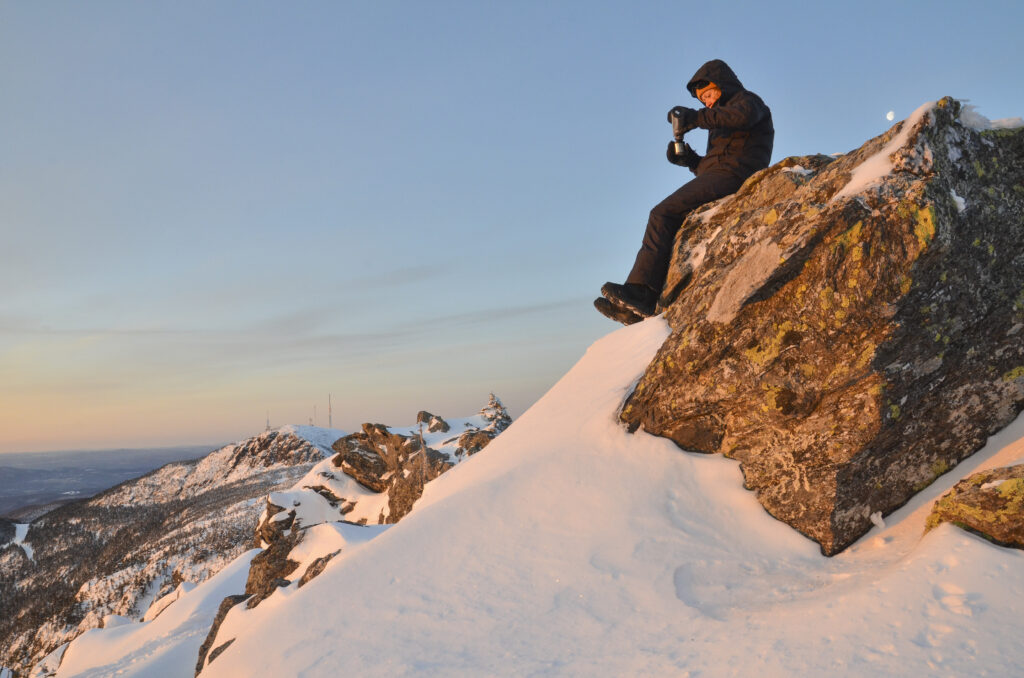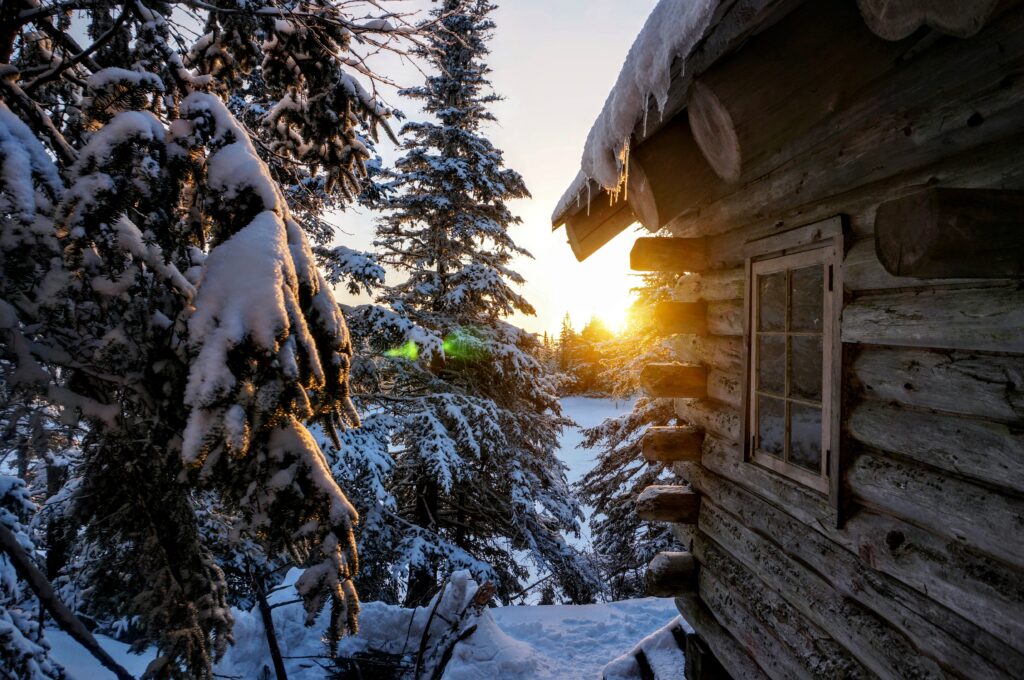Embrace the beauty, as well as the challenges of the winter season with the help of our winter hiking bucket list. It isn’t as easy to get outdoors during winter as it is in the warmer months of the year, but with the right preparation and willingness to push outside the summer and fall hiking season comfort zone, it’s worth it.
Strap on snowshoes or cross-country skis for the first time

Getting outdoors in winter doesn’t have to be hiking up Camel’s Hump or tearing down the ski slopes. Enjoying the season’s outdoor offerings can be as simple as a walk around your neighborhood.
You can try taking your adventures a step further by using snowshoes or cross-country skis on popular paths like the Smugglers’ Notch Road between Stowe and Cambridge, the Intervale’s recreational trails in Burlington, or rail trails like the Lamoille Valley Rail Trail and Missisquoi Valley Rail Trail. These activities offer a fun and different way to move through snowy terrain, even at the beginner level.
For those who may not own snowshoes or skis, trying these activities can be budget friendly too. Many local outdoor outfitters offer snowshoe and ski rentals with day rates between $20 to $40. Some local libraries also offer free snowshoe rentals.
Upgrade your safety training
No matter your experience level or intensity of activity, the safety stakes are simply higher in the winter. Cold temperatures, slippery trails, and darkness can make even the simplest injury into a life-threatening situation. Arm yourself with the reminders needed to recreate responsibly this winter. A few options:
- Review GMC’s “Intro to Winter Hiking” course which covers trip planning considerations and necessary gear.
- Follow SOLO’s schedule of Wilderness First Aid courses, a 2-day certification that will give you the basics of treating everything from hypothermia to fractures.
- If you ski or venture off trail in avalanche-prone areas (including parts of Vermont, the Adirondacks, the White Mountains, and beyond), consider an avalanche education course by East Coast Avalanche Education Center (4-day hybrid courses offered in Smugglers’ Notch, VT and Conway, NH, selling out quickly)
Enjoy a hot beverage at a summit

No matter where your winter treks take you, and whether you get there on foot, snowshoe, or ski, there’s nothing like a hot beverage when you reach your destination. Pack your favorite tea, hot coffee, or hot cocoa in a high-quality thermos, and relish in the steam released when you open it hours later.
Or, pack a small camping stove and prepare a hot beverage at the summit. We recommend testing your stove in cold temperatures to make sure it works. You can carry your own water or melt snow – if the latter, add a little bit of water to your pot first to prevent scorching.
Explore the Catamount Trail system
The Long Trail’s winter counterpart began in 1984 and was completed in 2007. This ski route spans the length of Vermont, made up of groomed and ungroomed ski trails, and sometimes co-located with the Long Trail or following networks of snowmobile trails. There are 31 different divisions and a wealth of opportunity to explore. The Catamount Trail Association’s website breaks down each division with an overview of the length and difficulty of the trails. You can also sign up for a guided tour or check out specific CT outings in this blog or check in with other skiers in the Catamount Trail Skiers Facebook Group.
Sign up for First Day Hikes
Join Vermont State Parks and GMC volunteers and take part in a national tradition to get outside on January 1. At least ten hikes are already scheduled around the state, exploring everything from the Colchester Causeway to Happy Hill shelter on the Appalachian Trail (led by UVO section volunteers Kathy Astrauckas and Bob Hagen).
Kick your year off and explore a new trail or visit an old favorite. Find more info from VT State Parks for the full list of hikes and to register.
Hike under the full moon

See your favorite trails in a different light (pun intended) with a moonlit hike. Although we still advise bringing headlamps, the light of a full moon adds a certain mystical look and feel to even the most familiar of trails when the woods are illuminated by moonlight reflecting off snow and ice.
A full moon will rise on December 15, January 13, and February 12. Plan your own outing, or join one of the hikes with one of GMC’s sections on our Calendar of Outings and Events.
Immerse yourself in the cold with a winter dip
The centuries-old practice of cold plunging or chilly dipping isn’t something new. But in recent years, it has gained widespread popularity as a wellness practice for the reported benefits to circulation and immunity, as well as mental health.
A few cold water groups regularly host community dips and are welcoming to cold-dipping first timers. It’s best to go with company, as either a newbie or practiced dipper, for both camaraderie and safety. Check out the Red Hot Chilly Dippers and Burlington Area Dippers Association (both groups dip mostly around the Burlington area). You can also experience the thrill of cold water with annual events like the Special Olympics Vermont Penguin Plunge and Lake Memphremagog Winter Swim Festival.
Sled down hills or mountains
Sledding is a classic activity this time of year. Bring out your inner child or involve the whole family. One of our top sledding locations is the auto road at Mt. Philo State Park. The road closes to vehicle traffic in winter, making it perfect for a nice walk up and a fun ride down. Or take it up a notch and opt to slide down the trail on your next hike. It’s not uncommon this time of year to see fellow hikers packing small portable single person sleds to use on their journeys back down to the trailhead.
Experience the world under the ice with ice fishing
Ice fishing is a Vermont classic. Anglers of all ages and background venture out onto frozen ponds and lakes, often erecting a small warming hut, and cut holes in the ice using an auger. You must bundle up especially well, since you’re not generating warmth by moving as you would be when hiking. Even though the world is frozen and cold, underneath the ice you’ll discover it’s still very much alive.
Recommendations from GMC staff include Lake Iroquois in Hinesburg, Lake Dunmore, Lake St. Catherine, and Lake Champlain around the Champlain Islands. As with all winter and ice activities, use caution and check ice conditions before venturing out. Vermont Fish and Wildlife has a primer on the fundamentals, and will run intro events later in the winter.
Attend a GMC Speaker Series Event
Fill the long winter nights by attending at least one of the many speaker events that are part of the James P. Taylor Outdoor Adventure Speaker Series. The series returns for its 33nd year in 2025 with presentations scheduled almost weekly from mid-January through February, all of which are free and open to the public.
The series includes presentations from advocates, athletes, scientists, wanderers, and more. The first speaker event will kick off with a dive into the experience of hiking the Triple Tiara (the mini-version of hiking’s Triple Crown challenge) with thru-hiker, ultrarunner, and LGBTQ+ advocate Aubri Drake on January 16.
Find presentation descriptions and links to register for each speaker here. And stay tuned for more additions to the lineup.
Winter camp or spend a night in a shelter or cabin

Try a night or two of winter camping. GMC’s Bolton Lodge, Hadsel Mares Cabin, and new Jean Haigh Cabin rental properties have several openings these next few months – plan a weekday stay for wider availability. All rental cabins are furnished with wood stoves and firewood for a cozy cabin experience.
Another option is GMC’s shelters, open year-round but not staffed with caretakers and regularly maintained during the winter months. Shelters are free to stay at and occupancy is first come, first served, although this time of year there are fewer people also vying for shelter space.
Camping in winter months does require more preparation and, depending on what kind of camping situation you choose, potentially more gear. Check out these winter camping do’s and don’ts to help you plan. Know what kinds of weather and temperature conditions you may be camping and hiking in, and know what is required to spend the night outdoors safely in them.
But backcountry travel isn’t required to check this item off your list either. Winter camping can count as pitching your tent setup in your backyard!
Check out ice formations

You can level up your winter day hikes by picking destinations known for unique and breathtaking ice formations. These form from various water runoff sources, and the most well-known are the ice columns on Laraway Mountain. The 3.6-mile out and back hike on the Long Trail starts in Waterville, on Codding Hollow Road.
In Smugglers’ Notch, you can catch ice climbers on the formations on Elephant’s Head cliff, or venture into a cave in Freedley’s Quarry in Dorset to see ice stalactites and stalagmites. Any waterfall can provide unique ice formations if it’s cold enough, so check out Thundering Brook Falls, Lye Brook Falls, and others.
Learn about winter wildlife at local nature centers
Visit the events calendars of your local nature center and community trails for winter programming. Check out North Branch Nature Center, NorthWoods Stewardship Center, Vermont Institute of Natural Science, and Audubon Vermont and save the dates of some of their events.
Skate across wild ice

“Wild ice” is the term given to natural bodies of water that freeze over in the winter, providing a dazzling and daring place to glide around on skates. The activity requires a fair amount of knowledge and preparation to stay safe, but you can start with some shallow bodies of water close to home.
In Burlington, the marsh around the Arthur Sea Caves freezes earlier than other, deeper bodies of water, and volunteers plow snow off to create skating paths. Lake Morey Resort in Fairlee maintains a 4.5-mile loop when conditions allow, and a one-mile loop as well.
Before venturing on to wild ice, we advise taking a course or traveling with someone who knows how to measure and scout ice. Wild ice skaters carry safety gear including a probe, ice pick, dry bag with clothes, flotation device, and more. Learn more in the Vermont Nordic Skating Facebook Group.
Many wild ice skaters wear Nordic skates, which are blades with a nordic ski binding, to allow for longer travel. Your old trusty figure or hickey skates will work too.
—
And of course, explore responsibly with the help of GMC’s winter hiking resources to aid cold weather preparation and safety. Share what’s on your list in the comments!





















Leave a Reply